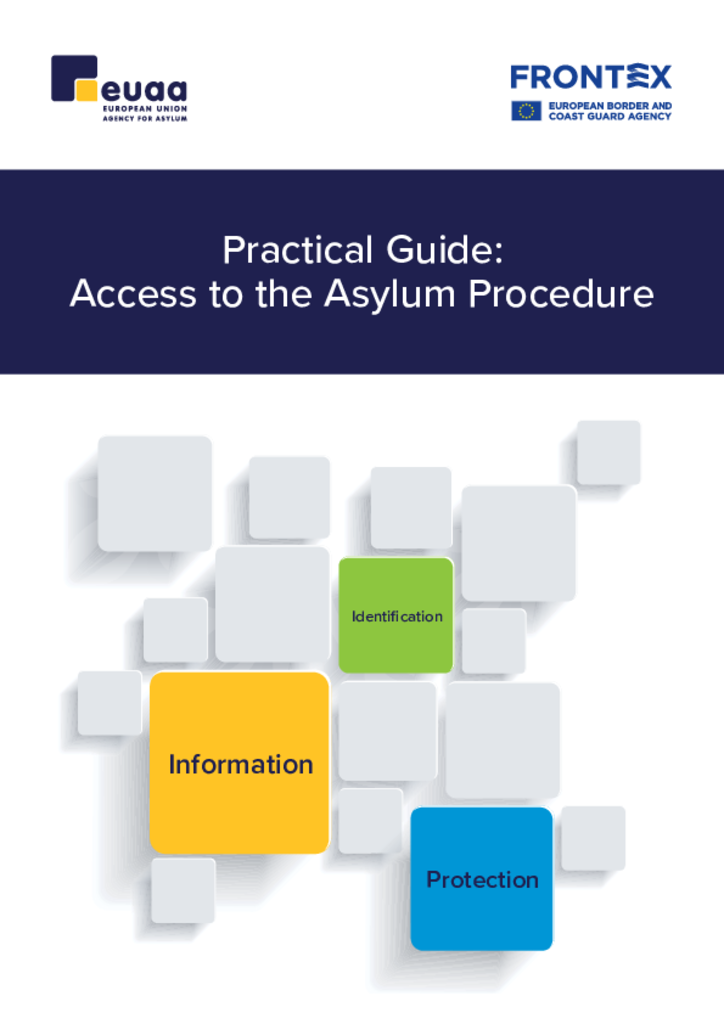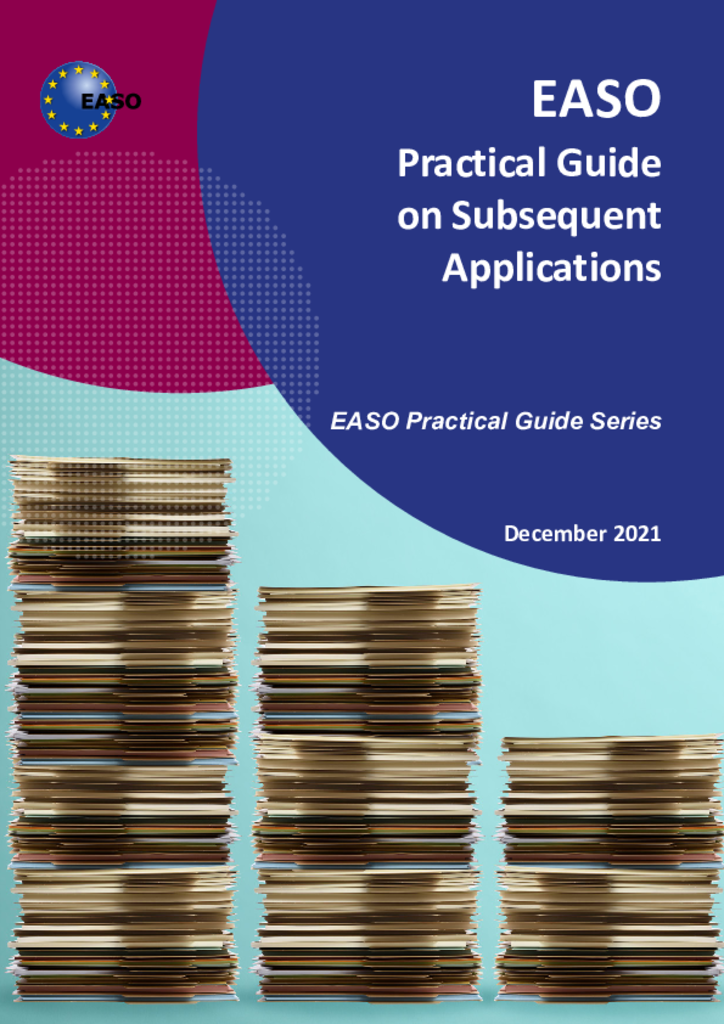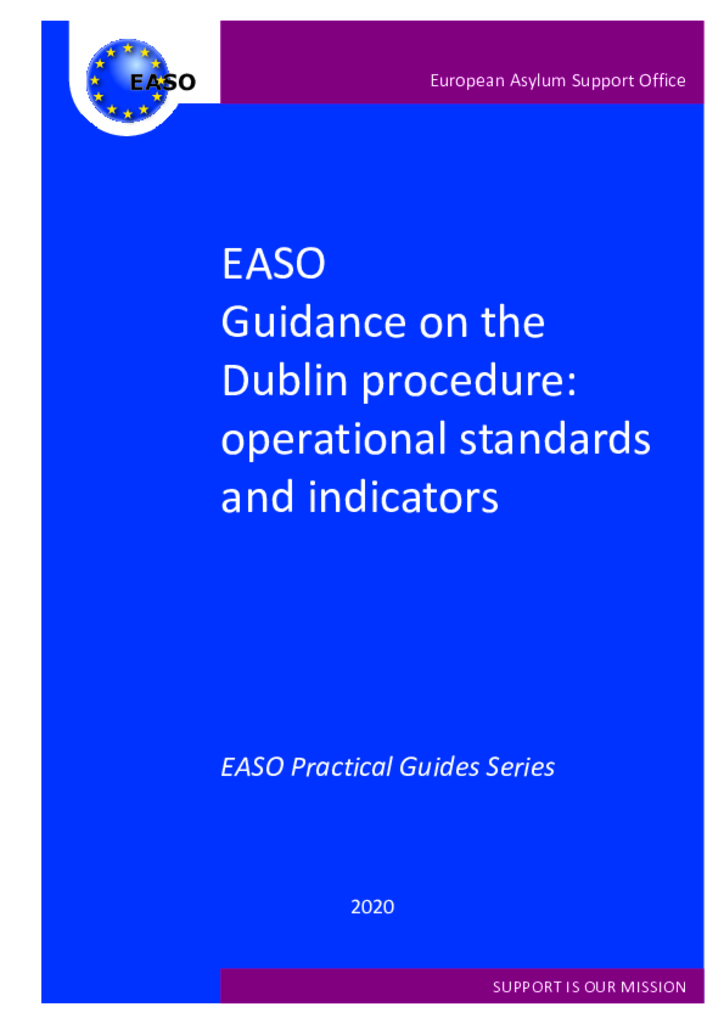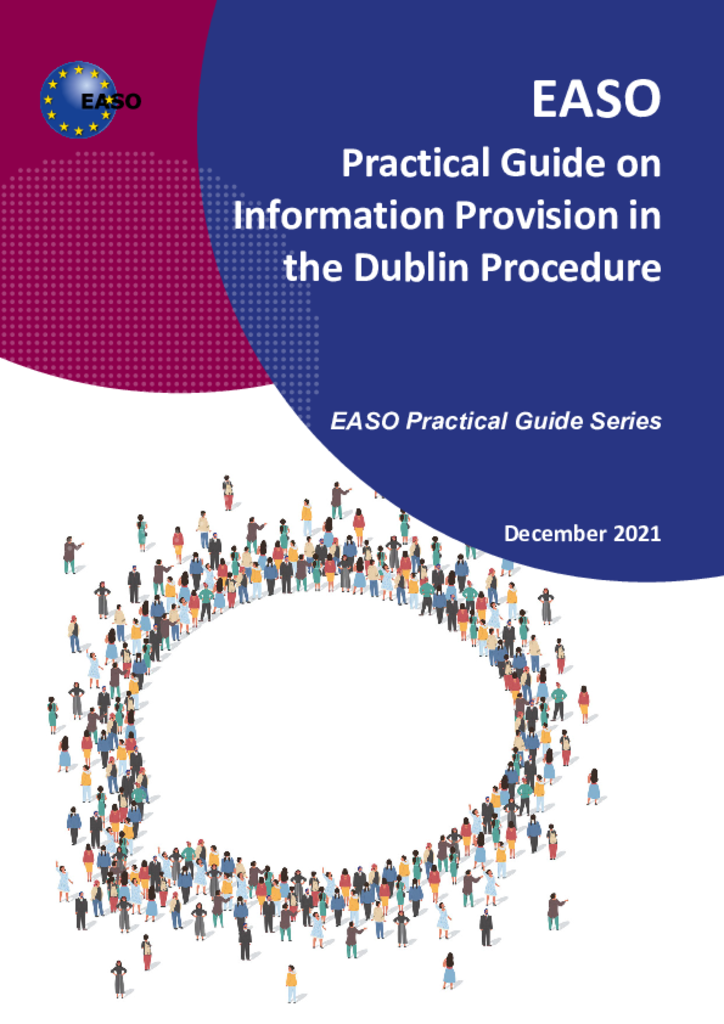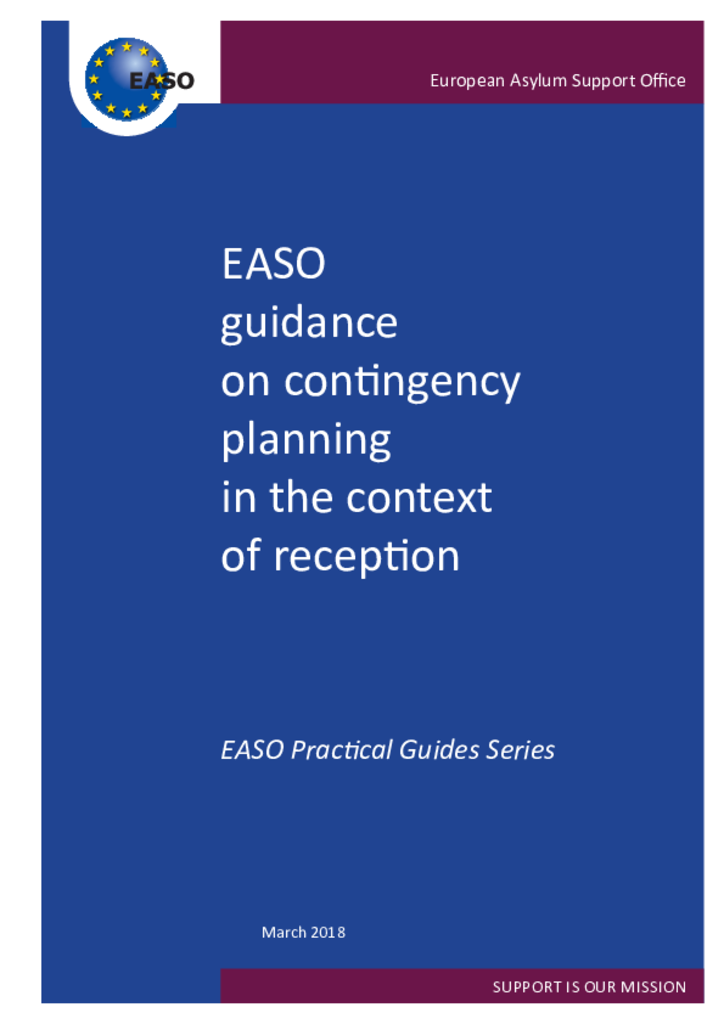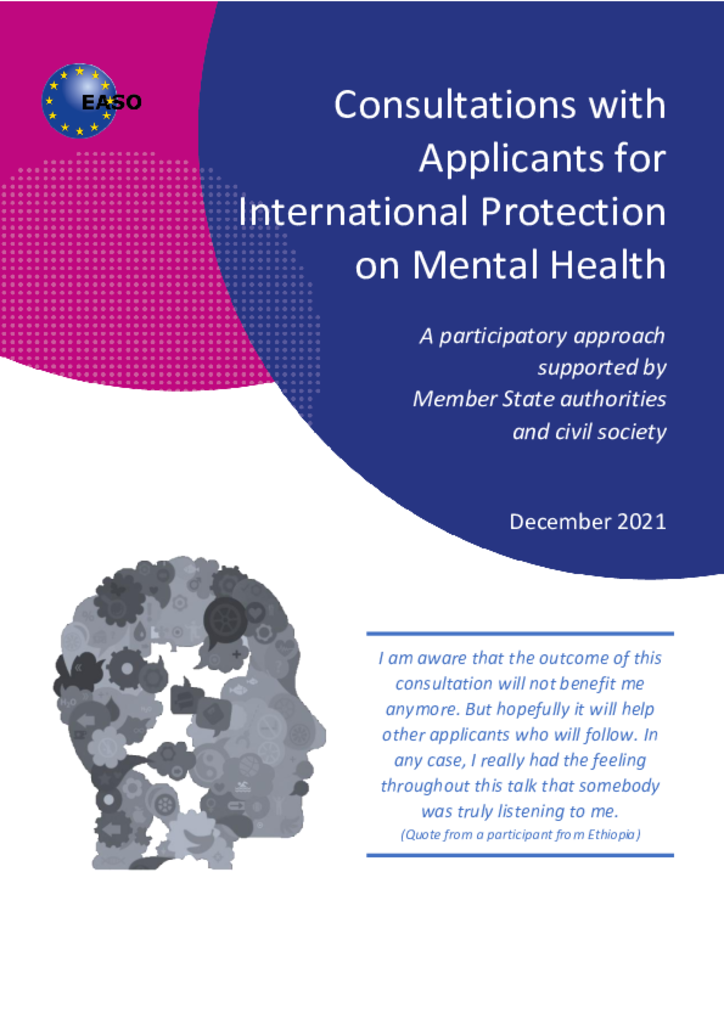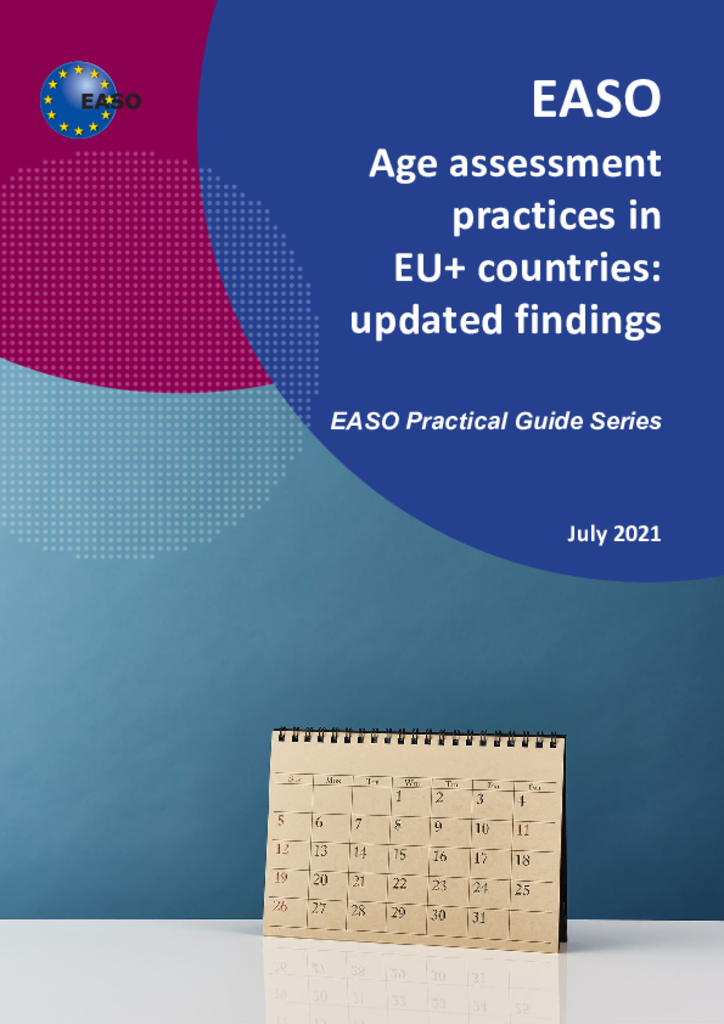The EUAA practical guides and tools help increase the knowledge and technical skills of asylum practitioners across the EU. The guides are commonly developed by and agreed with the members of the EUAA thematic networks and the approved by the Management Board. They establish operational standards and offer guidance in user-friendly formats, including checklists, pocket books, posters, web-based interactive tools, etc. For more information see Practical Tools and Guides Catalogue.
Click on the tabs for more details
Access to the asylum procedure and registration
Practical guides
This toolkit on access to the asylum procedure was jointly developed by EUAA and the European Border and Coast Guard Agency (Frontex), and in close collaboration with the European Union Agency for Fundamental Rights (FRA) and UNHCR.
The toolkit is intended to support the identification of third-country nationals and stateless persons who may wish to apply for international protection.
The toolkit includes:
- Practical guide: providing guidance on core obligations of the first-contact officials, the rights of persons in need of international protection and information on applicable procedural guarantees;
- Poster: presenting the 10 main messages on access to the asylum procedure;
- Pocket book: featuring the core principles and main messages;
- Leaflet on frequently asked questions: providing answers to some of the common questions that first-contact officials may have on access to the asylum procedure.
- Video: providing guidance on the core obligations of first-contact officials at the borders or in detention facilities.
This practical guide was developed to support information providers during the access to the asylum procedure. The guide describes information topics that need to be covered in the context of access to the procedure and provides methodological guidance in order to ensure efficient information provision. This practical guide was developed in the context of the EUAA Let’s Speak Asylum project, which provides a standardised set of practical tools for the implementation of information provision activities during the asylum procedures, the Dublin procedure, reception and resettlement. For more information visit the EUAA ‘Let’s speak asylum’ portal.
This practical tool presents a comprehensive approach for the lodging of applications for international protection. The tool is based on the relevant EU legal provisions and good practices gathered from Member States. It provides practical guidance to registration officers in their daily work and supports managers in strengthening the national registration process.
The tool provides structured guidance on registration procedures, including procedures related to special needs and Dublin considerations.
Examination of the application
Core practical guides
This practical guide intends to assist case officers and decision-makers in the examination of applications for international protection and application of the legal criteria on who qualifies for international protection, referring to both refugee status and subsidiary protection.
The guide includes checklists, guidance and references to legislation and case law in order to support the case officer in assessing whether the individual applicant qualifies for international protection.
The practical guide, which is also available in html format, includes a decision tree that describes all the steps in the decision-making process.
The decision tree flow chart is available in poster format.
This guide provides a comprehensive methodology and core guidance to the case officer on the three steps of the evidence and risk assessment:
- gathering information
- credibility assessment
- risk assessment.
It includes practical tools and features, such as a checklist, flowcharts and examples.
Being the first practical tool developed within the EASO Quality Matrix process, this practical guide is designed to assist case officers across the EU and beyond in their daily work by providing a practical checklist and brief guidance in five stages relating to the conduct of the personal interview.
This includes preparation for the personal interview (Section 1), opening the interview and providing information (Section 2), conducting the interview (Section 3), including guidance regarding the substance of the application which needs to be explored during the interview (Section 4), and closing the interview and post-interview actions (Section 5).
The guidance provides hyperlinks to legal references which can be accessed directly for further consultation.
Thematic practical guides

The practical guide and tools on Interpretation in the Asylum Procedure are primarily intended for interpreters working in the asylum procedure.
They include:
-
Practical Guide on Interpretation in the asylum procedure
The practical guide informs interpreters on what to expect when performing their tasks, explains their role and key principles to uphold, and provides guidance on how to interpret in line with international standards.
-
Essential Rules on Interpretation in the Asylum Procedure
The poster describes ten essential rules to keep in mind when interpreting in the asylum procedure.
-
Checklists on Interpretation in the Asylum Procedure
The checklists can be used by interpreters:
- before undertaking their assignments, to remind themselves of key aspects necessary to ensure the quality of their interpretation;
- after completing their assignments, as a self-assessment tool to identify which aspects need to be improved.
This practical guide aims to provide case officers with a framework for the examination of applications for international protection based on political opinion.
This practical guide aims to help case officers conduct fairer and more efficient interviews in view of the complexity and challenges posed by religion-based asylum claims.
The guidance provided seeks to improve case officers’ understanding of the concept of religion in the context of international protection and to support the creation of appropriate conditions for the personal interview.
This practical guide aims at providing guidance to case officers when examining the application of cessation clauses and to policy officers as well when implementing national workflows in the context of the cessation process.
The tool is structured in two layers of content, which address the application of the cessation clauses in a comprehensive manner:
Guidance on the substance of the assessment of the cessation provisions: individual behaviour of the beneficiaries leading to cessation; change of circumstances in the country of nationality / habitual residence; exemptions to the application of cessation; legal consequences of cessation; special circumstances when examining cessation;
Guidance on the implementation of the cessation process in practice: workflows of the cessation process; procedural considerations during the implementation; checklists, points to consider and practical examples in the context of personal interviews on cessation, application of the burden of proof in cessation, legal analysis of cessation decisions.
The guide also reflects on the special circumstances when examining cessation such as on practical challenges encountered when communicating with beneficiaries and on the organisation of large-scale cessation exercises.
The aim of this tool is to provide guidance to case officers on the examination process and the special procedural rules for assessing subsequent applications. To this end, the tool is focusing on three main aspects:
- specific rules of procedure applied for the assessment of subsequent applications;
- interpretation and application of relevant concepts related to subsequent applications;
- exploration of the specific situations in which a subsequent application could be submitted.
This practical tool aims at providing guidance to case officers and decision makers on the internal protection alternative (IPA) and its application. The guide reflects on relevant case law, national practices and provides practical examples for when case officers explore and assess the IPA during all steps of the procedure, such as during the interview and decision-making.
The guide outlines the parameters that need to be taken into consideration by case officers when identifying a potential IPA location and when assessing the IPA criteria in order to decide on its application. This includes the examination of safety; travel and admittance; and the reasonableness to settle in the IPA location.
This practical guide is complemented by commonly encountered profiles of applicants and points to consider when case officers assess the IPA criteria, as well as with specific considerations regarding the application of IPA in relation to cessation clauses and subsequent applications.
This practical tool provides guidance to case officers on the practical use of country of origin information (COI) at different stages of the asylum procedure – when preparing and conducting the personal interview and when carrying out the credibility assessment and the risk assessment of the application for international protection. The practical guide is complemented with information about COI sources and practical tips for basic COI research.
The tool is structured in two layers, which can be used independently:
- guidance through the different parts of the procedure of examining the application for international protection highlighting the role of COI and its standards;
- a checklist of recommended steps during the procedure of examining the application for international protection related to the use of COI.
This practical tool aims to support Member States in applying the concept of membership of particular social group (MPSG) as one of the 1951 Geneva Convention grounds of persecution in the examination process of applications for international protection. This soft convergence tool provides guidance in applying the same legal criteria and common standards when determining who qualifies for international protection.
The guide provides a set of principles and their application, structured in four main parts:
- legal basis of the concept of MPSG;
- legal analysis of the MPSG definition;
- the nexus between MPSG and persecution or absence of protection;
- commonly encountered profiles for which MPSG might be considered.
Recommendations
This document was developed in the context of the COVID-19 emergency situation. The document focuses on alternative solutions for registration (lodging) of an application for international protection. It provides practical recommendations on how to introduce remote, online or IT elements into the registration process in order to render the overall process more efficient and better organised. The guidance has been developed as a result of thematic meetings held by the EASO Asylum Processes Network and builds on information provided by EU+ countries, good practices, as well as EASO practical tools. Furthermore, this document elaborates procedural safeguards and practical recommendations that asylum authorities may want to consider when facilitating the lodging of applications for international protection online/remotely.
This document was developed in the context of the COVID-19 emergency situation. The aim is to provide brief guidance on remote personal interviews based on good practices from across the EU+ countries and existing EASO guidance. Furthermore, this document elaborates procedural safeguards and practical recommendations that asylum authorities may want to consider when preparing and conducting a remote personal interview, including the following aspects:
- technical arrangements, security and confidentiality;
- practical arrangements prior, during and after the interview;
- legal considerations;
- interview techniques and quality-related consideration;
- vulnerability-related considerations.
Quality Matrix
The report gives an overview practices of EU+ countries’ asylum administrations related to the personal interview, evidence assessment and qualification, focusing on overall trends. The aim of the report is to give interested parties an insight in the practices of EU+ countries’ asylum administrations at a general, aggregated level.
Video / animation
Core Practical Guides on the Examination of the Application for International Protection
This video presents shortly the Practical Guides on Personal Interview, Evidence Assessment and Qualification for International Protection. These guides support case officers in EU+ countries with their daily work on examining applications for international protection.
Dublin procedure
Operational standards and indicators
Practical guides
This practical tool has been developed to support Dublin practitioners in their daily work in the implementation of the Dublin III regulation.
The guide looks at two particular topics in the context of the Dublin procedure, personal interview and evidence assessment.
The guide is structured in three layers, which are to be used independently or in an interlinked manner:
- guidance through the different elements of the conduct of personal interview and evidence assessment in the context of the Dublin system;
- checklists as a practical reminder for those conducting personal interviews and evidence assessment;
- references to legislation, relevant case-law and additional sources.
Recommendations
The recommendations provide guidance reflecting commonly agreed best practices in the field of Dublin transfers. These recommendations are intended for all staff categories that are involved in the planning, organisation and execution of Dublin transfers. The majority of the recommendations are intended for Dublin case officers and staff in Member States authorities working operationally on Dublin transfers.
Exclusion
Practical guides
This guide provides a brief reminder of the main elements of the exclusion examination and explains the constitutive elements of the serious (non-political) crimes ground, the interplay between exclusion for serious (non-political) crimes and closely related provisions, as well as its relation to criminal proceedings.
Additional information on circumstances that can be taken into account as part of the individual analysis of the seriousness of a crime and regarding relevant principles and notions of criminal law and criminal procedure law can be consulted in the annexes.
EASO has developed a practical guide to assist in the detection and examination of potential exclusion cases. The guide focuses on exclusion grounds under Article 12(2) and Article 17 Qualification Directive (2011/95/EU) and covers the following aspects:
- what is exclusion?;
- detection of potential exclusion cases;
- referral and procedural guarantees;
- interview with a focus on exclusion: preparation and conducting the interview;
- evidence assessment;
- legal analysis: qualification of excludable acts and individual responsibility;
- drafting the decision elements related to exclusion;
- referral for investigation and/or prosecution.
This tool consists of checklists, brief guidance and references to relevant legislation and case law. It also envisages dedicated space for capturing national approaches.
Quality assurance in the asylum procedure
Operational standards and indicators
This guidance provides operational standards and indicators on contingency planning in the asylum procedure in order to help EU+ countries to build or review their national contingency plans based on the proposed standards.
The overall objective of this guidance is to support Member States in the practical implementation of key provisions of the Asylum Procedures Directive (2013/32/EU) to achieve fair and effective asylum procedures and to strengthen the CEAS at an operational level. The guidance can also serve as tool to strengthen national asylum procedures at policy level and as reference for the development of national monitoring frameworks and conduct of self-assessments of the asylum procedure. Built on existing practices that can be found within the EU, this guidance formulates commonly acknowledged operational standards and indicators that are realistic and achievable across all Member States and provides examples of good practice.
The guidance is structured in three areas of interest: access to procedure, guarantees for the applicants and examination of the application.
Practical guide
This guide aims to support asylum administrations to implement a quality assurance methodology in the asylum procedure and further develop their quality management systems.
At the same time, the guide explains how measures can be implemented in practice to ensure the quality of personal interviews and first-instance decisions.
Practical tools
EUAA has developed a tool to provide EU+ countries with a common framework for quality assessment of the examination of applications for international protection. The tool allows for a systematic quality review of personal interviews and the first-instance decisions in substance and on admissibility grounds (safe third country concept). The tool includes:
Video / animation
Quality in the context of the asylum procedure
The animation presents the main principles of quality in the context of the asylum procedure and explains how the EUAA supports the EU+ countries in assuring quality. Good quality is achieved through a procedure that is fair, efficient, transparent and in accordance with legal standards.
Reception
Guidance
This guidance is intended to provide support to EU+ countries in the implementation of key provisions of the Reception Conditions Directive (2013/33/EU), while ensuring an adequate standard of living for unaccompanied children that takes into account their special reception needs. It can be used at both policy and operational level as a framework for further development of reception standards at national level and as a tool to support reception authorities working with unaccompanied children in planning and in running of reception facilities and providing adequate care according to specific needs.
The standards and indicators laid down in this guidance address the specific needs of unaccompanied children in reception facilities, though the guidance may also be applicable for accompanied children.
The guidance is structured in nine sections providing respective standards, measurement indicators as well as good practice:
- information and representation
- identification of special reception needs of children
- allocation
- day-to-day care
- staff
- healthcare
- education
- food and clothing
- housing.
The tool is complemented by the IT app https://arc.euaa.europa.eu
This guidance aims to assist Member States’ reception authorities in their preparedness and ability to cope with situations of mass influx or unexpected events.
The tool provides detailed guidance on contingency planning to facilitate early action, manage future uncertainty and help anticipate and solve problems related to potentially high-influx situations.
The guidance is structured in 13 sections, complemented with checklists and following an integral approach to contingency planning.
These sections include:
- management and decision-making
- information management
- external coordination
- budget management and financial resources
- housing capacity
- resource management
- human resources
- minimum standards relating to reception conditions
- security/safety and prevention.
This guidance is intended to provide support to Member States in the implementation of the key provisions of the Reception Conditions Directive (2013/33/EU). It can be used at both policy and operational level as a framework for further development of reception standards at national level and as a tool to support reception authorities in planning and in running of reception facilities.
The guidance is structured in eight key sections, reflecting key areas of directive, providing respective standards, measurement indicators as well as good practice:
- housing
- food
- clothing and other non-food items
- daily expenses allowance
- healthcare
- provision of information and counselling
- identification, assessment and response to special needs
- staff training.
The tool is complemented by the IT app arc.easo.europa.eu.
Practical tools
EUAA practical tool on the design and management of modular reception centres
The publication aims to be a guide to relevant stakeholders (e.g., national, regional and local authorities, as well as civil society organisations) when designing and building new reception centres according to the agency’s standards and guidelines.
This IT tool provides a practical solution for EU+ countries as it allows authorities to conduct self-assessments of reception conditions at national level. It rests on the common reception standards and indicators outlined in the two EASO guidance documents on reception published in 2016 (general) and 2018 (unaccompanied children).
Available both as an app and as an offline software, the tool allows EU+ countries to collect, process and share data on performance of reception facilities.
Core technical functionalities of the tool include:
- assessment along with a check box of each relevant indicator with tips and guiding examples provided;
- report production including statistics, graphs and comments on the implementation of standards and indicators;
- voice recognition (EN) for easy recording of comments during an assessment.
Additional content is also available:
- operational tips for indicators with practical examples on how to assess a given indicator;
- assessment methodology including participatory approach and residents’ feedback (to be developed upon completion of the tool);
- a qualitative and quantitative reporting format.
Recommendations
Vulnerability and special needs
Practical Tools

This booklet is a guide for guardians of unaccompanied children specifically focusing on transnational procedures in the framework of international protection. It covers Dublin, Relocation, and Legal pathways (resettlement, complementary pathways and family reunification procedure - regulated by Directive 2003/86/EC). It includes an overview of these procedures with a specific focus on children, the related guarantees and the role of a guardian in the different phases of the procedures.
This tool introduces newly-appointed guardians to the concept of international protection, possible forms of protection recognised through the asylum procedure, the relevant legal framework and the rights of the child in the procedure.
A tool to support guardians assigned to children in their daily tasks and responsibilities throughout the asylum procedure. The tool includes an overview of the asylum procedure with a specific focus on children, the guarantees for children and the role of the guardian in the different phases of the asylum process. The tool also covers the guardian should do if something unexpected happens, if the age is disputed and how to guarantee a durable solution for the child.
How can I support my child during difficult times?
This pocketbook targets applicant parents who notice a change in the behaviour of their children, caused by psychological distress or accumulation of trauma. The tool provides basic tips on how to support them in feeling better. It can also be used by professionals working with families for the purpose of raising awareness. The tool is complemented by instructions.
How can I deal with situations in which my parents seem sad, worried, or angry?
This pocketbook targets applicant children who notice a change in their parent’s behaviour due to psychological distress or accumulation of trauma. The tool provides some basic tips on how to stay safe and ask for support. It can also be used by professionals working with children to raise awareness on the topic of distress. The tool is complemented by instructions.
How to handle situations when my friend or sibling is sad, angry or does dangerous things?
This pocketbook targets children who notice a change in their friends or siblings behaviour due to psychological distress or accumulation of trauma. The tool provides some basic tips on how to stay safe and ask for support. It can also be used by professionals working with children to raise awareness on the topic of distress. The tool is complemented by instructions.
The IPSN Tool is an interactive online solution which allows the user to identify potential special needs in the context of the asylum procedure and reception.
It supports the identification of 14 different categories: accompanied and unaccompanied children, disabled people, elderly people, pregnant women, single parents with minor children, victims of human trafficking, persons with serious illnesses, persons with mental disorders, persons who have been subjected to torture, to rape or to other serious forms of psychological, physical or sexual violence, LGBTI and people with gender-related special needs.
The tool suggests special guarantees focusing on five aspects:
- first contact – making an application
- reception support
- lodging the application
- personal interview
- end of the first instance asylum procedure.
Based on the selections made by the user, the tool generates a report, which can be further individualised with a reference number and relevant notes, before being saved and/or printed.
The SNVA tool is designed to support MS authorities in the assessment of the special needs of persons in a situation of vulnerability. It aims to support specialised staff in assessing special needs in a structured way and to identify appropriate future actions to be taken in the interest of the applicant. A timely response and a prompt access to services will also avoid vulnerable applicants to become more vulnerable due to delayed service provision.
The users of the tool are specialised professionals tasked to assess the needs of persons in a situation of vulnerability and to take actions in order to provide timely and adequate response to those needs.
This practical tool is intended to support relevant authorities in improving their referral mechanisms for all categories of vulnerable persons in need of international protection. It presents a structured system of referral which can serve as a model for the development or improvement of national referral mechanisms and includes regional and local perspectives. It could also serve as an information provision tool for applicants looking for support.
The tool offers guidance in three main parts:
- standard referral form
- mapping practical tool
- referral mechanisms guidelines.
The tool is an integral part of the EASO Vulnerability Toolkit comprising the EASO Identification of Persons with Special Needs Tool (IPSN) and the EASO Special needs and vulnerability assessment tool.
This tool focuses on temporary protection.
It aims at assisting guardians appointed by Member States in supporting displaced children from Ukraine when registering for the temporary protection and exercising their rights.
The age assessment booklet for children complements an animation produced by the agency on the topic of age assessment for children. The content in the booklet is prepared in a child-friendly manner to further inform young persons arriving in Europe who might have to take part in an age assessment.
Practical Guidance
This guide is intended to assist managers and staff working in the field of asylum and reception with methods, tools and a roadmap to maintain staff wellbeing and ensure a safe and healthy working environment for asylum professionals working with applicants for international protection. The guide is composed of three interlinked parts.
- Part I: Standards and policy proposes eight standards to guide staff welfare policy formulation, implementation and evaluation in the asylum and reception settings of EU+ countries.
- Part II: Staff welfare toolbox proposes a range of practical tools, measures and soft skill training suggestions to be used by managers and first-line workers to meet the standards in staff well-being introduced under Part I.
- Part III: Monitoring and evaluation recommends measures to be put in place to evaluate staff welfare policies and assess how and if the well-being of staff is positively impacted by measures introduced.
The guide is complemented by a video animation on the early identification of signs of stress. It is aimed at promoting staff welfare in the area of reception and asylum. The animation presents the key elements of recognising signs of stress in an easy to understand way. It also presents the responsibility of teams and colleagues in this process and the simple steps to take to address the well-being of the staff members concerned.
The importance of early identification of signs of stress
This practical guide is intended to support competent Member State authorities in applying the principle of the best interests of the child and enhancing the guarantees within asylum procedures for children.
The guide is structured in four sections:
- background elements of the best interests of the child;
- relevant guarantees;
- guidance on how to assess the best interests in practice;
- vulnerability and risk indicators.
The guidance is complemented with an overview of the terminology, a comprehensive checklist as well as relevant policy, guidance and legal framework documents.
This practical guide is intended to support EU+ countries in the implementation of the principle of the best interests of the child when assessing the need for age examination and when designing and undertaking age assessment.
The guide is structured around five interlinked pillars and offers:
- analysis of the impact of age assessment on other rights of the applicant;
- guidance on the application of the necessary principles and safeguards in the assessment process;
- guidance on implementing the assessment process using a holistic and multidisciplinary approach;
- overview of age assessment methods conducted by EU+ countries;
- key recommendations to address practical challenges.
The practical guide provides a set of tools and reference documents such as glossary of terms, international, European and national legal framework and a checklist. It is complemented by two video animations for practitioners and children, respectively (more on page 29).
This guide provides a set of guidance and reference materials to support EU+ countries regarding family tracing, as well as a mapping of current practices of family tracing across EU+ countries.
The guide is constructed around four interlinked pillars:
- introduction to the topic by outlining the circumstances of family tracing;
- a visual outline of the family tracing process, including applicable principles and guarantees;
- overview of current family tracing practices across the EU+ countries;
- conclusions and recommendations promoting consistent standards and guarantees.
Reference materials in the guide include glossary of relevant terms, legal framework, list of relevant projects and initiatives, relevant publications, and a mapping of the practice of EU+ countries.
Reports
This report analyses the latest developments and systems currently in place to manage asylum applicants with disabilities. The information is based on publicly-available sources and submissions to two EUAA surveys
This situational update accompanies the analytical report on asylum applicants with disabilities and focuses on current practices and the latest developments related to displaced Ukrainians with disabilities.
Identification, support and examination of claims - Mapping report
Building on a survey on victims of torture in the EU+, the report touches on medico-legal reporting, national practices and key steps to support the authorities.
This mapping report captures the results of a targeted survey launched in 2021 on the topic of incident management. The survey and report focus on the following topics: the types of critical incidents observed in reception and the personal interview situation; understanding how incidents are currently documented, reported and responded to; and where and what the main gaps are. The findings will facilitate the design of tailored and relevant EUAA support to Member States.
This consultation report aims to capture the voices of applicants for international protection with respect to mental health concerns some face in asylum and reception. The report lists a set of recommendations by applicants on how to improve reception and the personal interview setting to strengthen resiliency.
The report is part of EASO’s effort to support Member States to enhance identification and response to the mental health concerns of applicants for international protection in the reception context and in the asylum procedure. The report maps the main signs and sources of mental health concerns in applicants for international protection and main challenges faced by first line workers in their daily engagement with such applicants.
The report traces practices across EU+ countries in dealing with mental health concerns of applicants and highlights gaps, good practices as well as formulates recommendations in four key areas:
- identification and response
- referral and collaboration
- support
- monitoring, documentation and sharing of information.
These findings represent an update to the Agency findings dating from 2016. They were developed based on the information on the age assessment methodologies and procedural safeguards mapped across the EU+ territory, and show how age assessment, and in particular some of the methods, has rapidly evolved in the past few years.
The report is part of EASO’s effort to help Member States mainstream child-related issues in asylum procedures. The report presents national practices and policies on asylum procedures for children, identifying gaps and areas of diverging practice across Member States, highlighting good practices, and providing key recommendations to strengthen the protection of children across the EU.
The report traces the practices across EU+ countries along four key topics:
- best interests of the child in asylum procedures;
- asylum procedures for children;
- referral;
- specialisation and training of staff.
The report provides operational definitions and recommendations to respond to the identified challenges undermining the effective protection of children in asylum procedures.
Videos
This animation explains the concept of Psychological First Aid (PFA) to first line officers by emphasising 5 basic principles: promoting safety, calm, self- and collected efficacy, connectedness and hope. Observing these principles, applicants can be helped to re-establish a sense of safety and calm and to stabilise. Approaching applicants with empathy is crucial for their wellbeing.
The animation is complemented by instructions on how to use the animation to create awareness on PFA in first line officers interested in the topic, new recruits and volunteers.
This animation points to basic safeguards and guarantees that are to be provided during registration. It is built on the story of a 17-year-old girl who is applying for asylum in Europe together with her husband.
The animation could be used for information sharing purposes, as well as during training courses as a discussion trigger with staff working for asylum authorities.
Two video animations complement the practical guide on age assessment:
The animation on “Age assessment for practitioners” is directed at reception and asylum officials, migration and law enforcement officers, social workers, radiologists, paediatricians, public prosecutors and other stakeholders. It presents in an easy-to-understand way the key elements of the guidance and the necessary safeguards to ensure a right compliant and reliable age assessment.
The animation on “Age assessment for children” intends to inform children and youth about what to expect when asked to undergo an age assessment.

